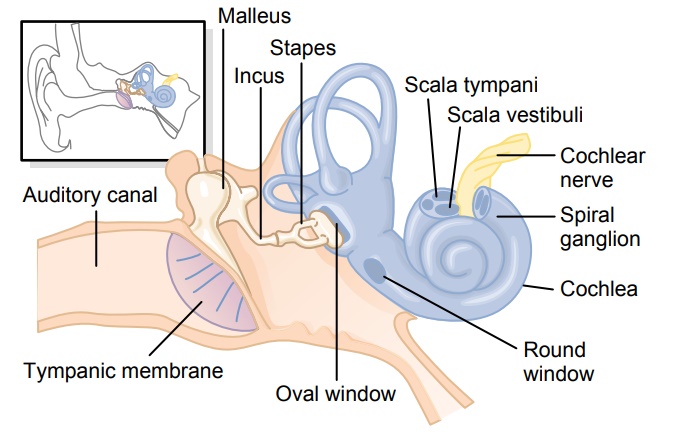Chapter: Medical Physiology: The Sense of Hearing
Tympanic Membrane and the Ossicular System

Tympanic Membrane and the Ossicular System
Conduction of Sound from the Tympanic Membrane to the Cochlea
Figure 52–1 shows the tympanic membrane (commonly called the eardrum) and the ossicles, which conduct sound from the tympanic membrane through the middle ear to the cochlea (the inner ear). Attached to the tympanic membrane is the handle of the malleus. The malleus is bound to the incus by minute liga-ments, so that whenever the malleus moves, the incus moves with it. The oppo-site end of the incus articulates with the stem of the stapes, and the faceplate of the stapes lies against the membranous labyrinth of the cochlea in the opening of the oval window.
The tip end of the handle of the malleus is attached to the center of the tym-panic membrane, and this point of attachment is constantly pulled by the tensortympani muscle, which keeps the tympanic membrane tensed. This allows soundvibrations on any portion of the tympanic membrane to be transmitted to the ossicles, which would not be true if the membrane were lax.

The ossicles of the middle ear are suspended by ligaments in such a way that the combined malleus and incus act as a single lever, having its fulcrum approx-imately at the border of the tympanic membrane.
The articulation of the incus with the stapes causes the stapes to push forward on the oval window and on the cochlear fluid on the other side of window every time the tympanic membrane moves inward, and to pull backward on the fluid every time the malleus moves outward.
“Impedance Matching” by the Ossicular System. The amplitude of movement of thestapes faceplate with each sound vibration is only three fourths as much as the amplitude of the handle of the malleus. Therefore, the ossicular lever system does not increase the movement distance of the stapes, as is commonly believed. Instead, the system actually reduces the distance but increases the force of movement about 1.3 times. In addition, the surface area of the tympanic mem-brane is about 55 square millimeters, whereas the surface area of the stapes averages 3.2 square millimeters. This 17-fold difference times the 1.3-fold ratio of the lever system causes about 22 times as muchtotal force to be exerted on the fluid of the cochlea as is exerted by the sound waves against the tympanic membrane. Because fluid has far greater inertia than air does, it is easily under-stood that increased amounts of force are needed to cause vibration in the fluid. Therefore, the tympanic membrane and ossicular system provideimpedancematching between the sound waves in air and the sound vibrations in the fluidof the cochlea. Indeed, the impedance matching is about 50 to 75 per cent of perfect for sound frequencies between 300 and 3000 cycles per second, which allows utilization of most of the energy in the incoming sound waves.
In the absence of the ossicular system and tympanic membrane, sound waves can still travel directly through the air of the middle ear and enter the cochlea at the oval window. However, the sensitivity for hearing is then 15 to 20 decibels less than for ossicu-lar transmission—equivalent to a decrease from a medium to a barely perceptible voice level.
Attenuation of Sound by Contraction of the Tensor Tympani and Stapedius Muscles. When loud sounds are transmittedthrough the ossicular system and from there into the central nervous system, a reflex occurs after a latent period of only 40 to 80 milliseconds to cause contrac-tion of the stapedius muscle and, to a lesser extent, the tensor tympani muscle. The tensor tympani musclepulls the handle of the malleus inward while the stapedius muscle pulls the stapes outward. These two forces oppose each other and thereby cause the entire ossicular system to develop increased rigidity, thus greatly reducing the ossicular conduction of low-frequency sound, mainly frequencies below 1000 cycles per second.
This attenuation reflex can reduce the intensity of lower-frequency sound transmission by 30 to 40 deci-bels, which is about the same difference as that between a loud voice and a whisper. The function of this mechanism is believed to be twofold:
To protect the cochlea from damaging vibrations caused by excessively loud sound.
To mask low-frequency sounds in loud environments. This usually removes a major share of the background noise and allows a person to concentrate on sounds above 1000 cycles per second, where most of the pertinent information in voice communication is transmitted.
Another function of the tensor tympani and stapedius muscles is to decrease a person’s hearing sensitivity to his or her own speech. This effect is acti-vated by collateral nerve signals transmitted to these muscles at the same time that the brain activates the voice mechanism.
Transmission of Sound Through Bone
Because the inner ear, the cochlea, is embedded in a bony cavity in the temporal bone, called the bonylabyrinth, vibrations of the entire skull can cause fluidvibrations in the cochlea itself.Therefore, under appro-priate conditions, a tuning fork or an electronic vibra-tor placed on any bony protuberance of the skull, but especially on the mastoid process near the ear, causes the person to hear the sound. However, the energy available even in loud sound in the air is not sufficient to cause hearing via bone conduction unless a special electromechanical sound-amplifying device is applied to the bone.
Related Topics